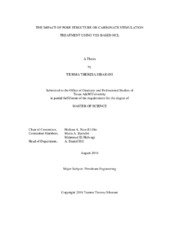| dc.description.abstract | Regular HCl has been used for years in carbonate stimulation treatment because it reacts rapidly with carbonate rocks. However, due to fast reaction, the acid reacts near the wellbore area and is not able to travel deeper into the formations. Viscoelastic surfactant has been added to increase acid viscosity and to lower the reaction between acid and carbonate. On the other hand, pore structures of carbonate are diverse and consist of various porosity systems such as intergranular, moldic pores, and vugs pores. The pore heterogeneity greatly impacts carbonate stimulation treatments. A pore-scale evaluation during stimulation design could lead to a more successful field treatment. This work proposes the study of viscoelastic surfactant (VES)-based hydrochloric acid (HCl) as a function of pore structures in carbonate rock. The results have revealed that flowing fraction, which represents pore heterogeneity, is higher in rock that has well-connected pores and lower in rock that has fairly connected pores. Preferential flow paths exist in the rock that has a lower flowing fraction. These paths lead to faster wormhole propagation, and thus less acid was required to reach breakthrough. Rock with a higher flowing fraction possesses higher fraction of the pores that allow more fluid to flow. This process caused more acid to come into contact with the carbonate rocks and more acid to be needed to reach breakthrough. The regained permeability is used to represent cleanup characteristic after acid injection. This study proves that rock with a higher degree of heterogeneity has better cleanup than rock with a lower degree of heterogeneity. It happens because heterogeneous rock has a lower flowing fraction, which corresponds to less remaining surfactants inside the matrix. Wormholes that have fewer branches were produced in rock with a lower flowing fraction. Fewer branches correspond to a less complex wormhole pattern and a lower fractal dimension number. Moreover, it is highly recommendable that surfactants are added into acid systems to reduce acid pore volume to reach breakthrough and to form uniform wormhole patterns. | en |


